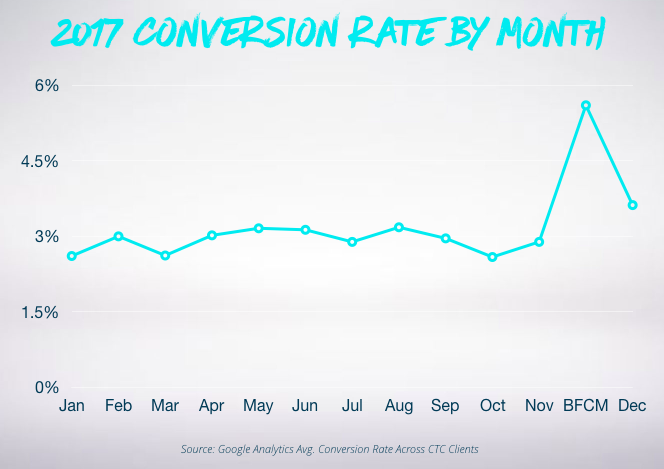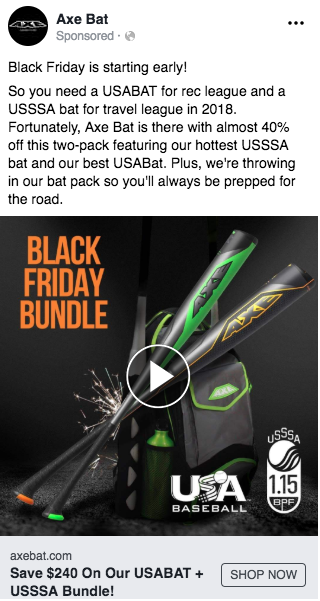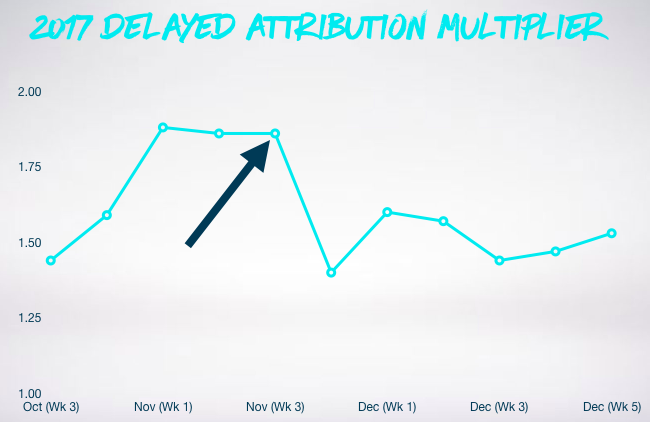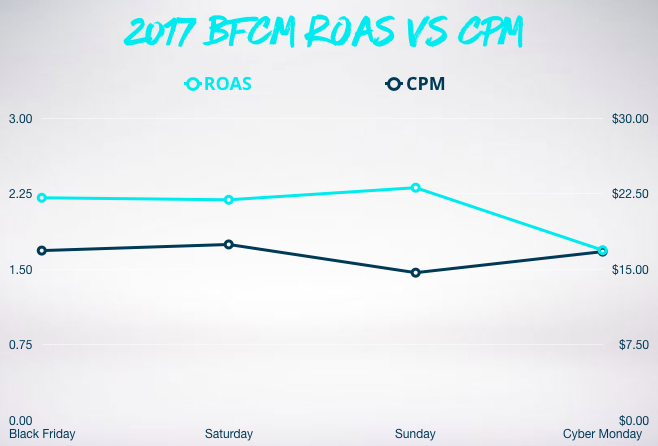The number one mistake you can make with your Black Friday/Cyber Monday (BFCM) Facebook ads is poor planning.
So our agency Common Thread Collective wanted to make it easy for you. No more guesswork. No more tedious data gathering. No more wasting time with gurus and their ebooks.
Today, I’m going to show you a data-driven five-part BFCM Facebook ads strategy, based on analyzing $6.85 million of our own clients’ Facebook ad spend data. The best part?
There’s nothing tricky or overly complicated about it. Just good planning and good marketing. Here’s how to do it:
%(tableofcontents)
Key #1: Know In Advance How BFCM Conversion Rates And Click Prices Will Rise And Fall
This is a photo of the main hallway wall in our office:

We have that there to remind ourselves that everything in ecommerce (in all business, really) comes down to only three factors:
-
How many visitors you get
-
How many of them purchase (conversion rate), and
-
How much money they spend when they do (average order value)
Multiply the three together and, voila, you’ve got a formula for how much money you’re making. That’s it. That’s the whole game.
The question is: how do you maximize all three variables during Black Friday/Cyber Monday?
Let me explain…
Fact: People buy more stuff over BFCM weekend.
You’re nearly guaranteed a huge bump in conversion rate over the BFCM weekend. Here’s what our clients’ average ecommerce conversion rate looks like across the whole year (on average it is around 2.85%):

Here’s what it looks like when you isolate BFCM from the rest of November (the conversion rate more than doubles to around 5.5%):

OK: the conversion rate spike is coming. So why not just spend your ad dollars to drive high-quality traffic to your website and watch the revenue pour in?
Because everyone else knows it’s coming too.
Facebook is a giant marketplace where our newsfeeds get auctioned off to the highest bidders. So when more bidders show up, and each one has more money to spend when they get there: the ad space gets more expensive.
How much more expensive? This much more expensive:

Depending on your industry and your customer base, the actual CPMs (cost per 1,000 impressions — the amount you pay for the ad space) may vary significantly, but the effect will almost certainly be the same: CPMs steadily increase up to BFCM, at which point they’re double what they are through “normal” times of the year.
What do higher CPMs mean for you? They mean higher cost per clicks (CPCs). If the ad space costs more and people are clicking on your ads the same amount as usual, then every click costs more money. Here’s that same CPM trend, this time with average CPC layered over it:

Increasing CPMs mean increasing CPCs. Step one is knowing this is going to happen. Step two is knowing how to take advantage of the trends.
Key #2: Ramp Up Your Traffic Three Weeks Before BFCM
The way to win BFCM is by winning the weeks leading up to BFCM. Let me show you the data first, and then I’ll lay out the strategy.
We already saw that CPMs peak at BFCM right along with conversion rates. So how do we take advantage of the conversion rate without paying top dollar for the clicks in the first place?
Simple. We buy the traffic ahead of time.
Last year in November, I wanted to buy a new pair of Reebok weightlifting shoes. Sometime in the first or second week of the month, I went to Reebok’s site, looked around, and found the pair I wanted.
You know what I did next, right?
I left the site and made a note to myself to come back on Black Friday to see what Reebok’s offer was. And when I did and found them for 40% off, I happily made my purchase and went on my weightlifting way.
I bet a lot of you did that same thing with your favorite products. Everyone knows that brands offer their best deals of the year on Black Friday or Cyber Monday, so they wait to purchase.
We can measure the way this affects your Facebook ads by tracking “delayed attribution.” Since Facebook tracks purchases in increments of 1, 7, and 28 days after someone clicks an ad and assigns credit back to the ad that was clicked, we can see how much revenue our ads are producing by tracking the increase in return on ad spend (ROAS) from 1, 7, and 28 days after the click. That’s the delayed part of the attribution.

To find the above data, go to your Facebook Ads Manager account > Columns > Customize Columns > Edit > Select the 1 Day, 7 Day, and 28 Day Click Attribution Windows.
Imagine a visitor clicks on my ad on September 1st, looks around my website, and then leaves without making a purchase. But then that same visitor comes back 21 days later without clicking another Facebook ad and now makes a purchase.
Facebook assigns the credit for the purchase to my September 1st ad.
In the screenshot above this sale would be attributed to the 28-day click attribution window. If you look at the Website Purchase ROAS columns in the screenshot above you’ll see that delayed attribution can significantly affect ROAS.
The problem is that if it’s Black Friday and I’m trying to adjust ads and budgets to maximize my returns, I don’t have time to wait 28 days to figure out if I’m being successful. I have to be able to use my 1-day revenue to project my 28-day revenue.
One way of doing this is by creating a “delayed attribution multiplier,” where we divide the 28-day Website Purchases Conversion Value by the 1-day Website Purchases Conversion Value. For example, if I was using the purchase values from row 1 in the screenshot above, my delayed attribution multiplier would be 1.45.
The more delayed attribution you get, the higher the multiplier. If you see a delayed attribution multiplier greater than your 1-day website purchases conversion value, you can project more revenue.
The size of the multiplier varies significantly from client to client, so if you don’t know your average delayed attribution multiplier, I recommend going now and figuring it out. For clients who are new to Facebook ads, we assume a (purposefully conservative) multiplier of 1.3 during normal times of the year.
But BFCM is not a normal time of the year.
So what happens when we expect lots and lots of people to do what I did with my Reebok weightlifting shoes last year? This is what happens:

See that? The delayed attribution multiplier in the three weeks leading up to BFCM (November, Weeks 1-3) is around 1.8 ROAS.
Which means that getting people to your website in the three weeks before the BFCM weekend is absolutely crucial. If they’re interested in your product, they will come back and buy when you roll out your BFCM offer.
Bank on it.
This is why CPMs are actually underpriced during those three weeks, even as they start to rise: many advertisers see one-day click returns below their targets and tell themselves to wait to really spend until BFCM. This leaves newsfeed space you can arbitrage because you’ve planned better than your competitors.
So here’s the tactic: buy the underpriced ad space for the three weeks leading up to your sale. Count on your ROAS looking bad at first. In fact, lean into it: during those weeks, drive your customers to a gift guide that previews your offer, so they know exactly how good of a deal they’re going to get if they wait.
Get them excited about it. Prospect heavily. Remarket heavily. Do it all. Just get interested people to your website as much as possible. Stay top of mind, and they will come back and buy.
That’s the foundation of your BFCM “website visitors” strategy. Get the clicks before the big weekend. Now let’s talk about the other big variable we haven’t yet: average order value (AOV).
Key #3: Build A BFCM Bundle Offer To Increase Your AOV
If you've got lots of people coming to your website and making purchases, you're already winning. If you've got them spending more per purchase? Dancing in the streets! And there is no better time to get people to buy more of your products than a holiday.
Here’s how you do it: start by building a BFCM Sitewide Offer that is going to appeal to your customers. I recommend doing something very straightforward, within these parameters:
-
At least 20% off (anything less than this tends to be ineffective unless your discount is at least $100 in raw dollar amount).
-
Don’t bother with coupon codes. Just mark down your site (or a particular collection, if that’s your style). This makes it easier for your customers, especially on mobile.
-
If you don’t discount much, you can keep that sale discount down at 20%. If you give people 20% often, you probably need to go higher to get people to take advantage of the offer.
Once you’ve figured out your core BFCM Sitewide Offer, take a step back and ask yourself: how can I bundle products and offer discounts to drive up AOV?
I saw this done most effectively last year by Axe Bat, an innovative and rapidly growing baseball bat brand. Axe Bat, who rarely discounts, put together a BFCM Bundle Offer page with their biggest discounts on their highest-priced bats (some of which retail for $300 more than their lowest-end models in the same category) and multi-bat bundles.

Since many bat customers need multiple bats (one for each kid, for example, or one for Slowpitch League and another for Little League), Axe Bat’s marketing team thought of every bundle they possibly could, then marked those bundles down a little more than 20%.
This combination of offers on big-ticket items and bundles ran alongside Axe Bat’s 20% off BFCM Sitewide Offer.
I’ll discuss how we timed the release of all these offers more below (stay tuned: it’s a crucial detail). For now, check out the results:
-
An 18% increase in AOV despite the sale
-
A 193% increase in conversion rate (yes, you read that correctly)
-
Multiple products in the hands of each customer
-
Axe Bat’s highest ROAS of the year
Another way of doing this is by stacking discounts. DIFF Charitable Eyewear did this to great effect by offering customers one pair of sunglasses at 30% off, two pairs at 40% off, and three pairs at 50% off. The result was a 17% increase in AOV.

Smart product offers lead to big AOVs, which leads to big BFCM revenue numbers.
So here’s the recommendation in three steps:
-
Come up with your BFCM Sitewide Offer.
-
Figure out what BFCM Bundle Offer makes the most sense for your brand, then mark it down a little more, percentage-wise, than your BFCM Sitewide Offer.
-
Build a landing page that makes your BFCM Bundle Offer as clear as possible.
Once you’ve got that structure, it’s time to run ads to your BFCM Bundle Offer. And here’s the big secret: you run them the week before Black Friday.
Key #4: Run Ads To Your BFCM Bundle Offer One Week Before BFCM (Then Advertise Your BFCM Sitewide Offer)
We’ve talked about CPM trends.
We’ve talked about delayed attribution.
We’ve talked about product bundling.
Now let’s put all those principles together by showing you the most surprising data point about your BFCM Facebook ads plan. Here it is: The 28-day ROAS (measured on a click-only attribution model) by week:

Do you see that? The biggest ROAS time period for our clients last year was not actually the BFCM weekend. It was the week before. Why is that and how do you take advantage of it?
First, here’s the same data, but this time with CPC, Conversion Rate, and AOV separated out.

Here’s the key to understanding why ROAS can be best over the week before BFCM: our best-performing brands (who blew these averages away) released their BFCM Bundle Offer the week before BFCM, but waited to release the BFCM Sitewide Offer until Black Friday.
That works, first, because it’s close enough to BFCM that if the offer really is good, people are ready to buy. So not only are the AOVs high before the CPCs are at their peak, but the BFCM conversion rate spike starts early there too.
A great BFCM Sitewide Offer + peak buying time + underpriced traffic + AOV-focused BFCM Bundle Offer = big-time paid traffic profitability.
But you don’t just win that week. You win on the weekend, too. And that’s the second reason it is so effective: the coming BFCM weekend guarantees the big delayed attribution multiplier we discussed earlier. Look again at the third week of November on this graph:

This is what really pushes this strategy over the edge. By running your BFCM Bundle Offer in advance of the BFCM Sitewide Offer, you are priming your customers to come back a second time on the BFCM weekend itself. So even if none of your bundles appeal to the customer, you’re still top of mind for them to check back in just a few more days.
I’m going to recap this here because I don’t want you to miss it. The strategy works like this:
-
Drive traffic for three weeks leading up to BFCM, ideally to a BFCM Gift Guide that features your upcoming offers.
-
Drive as much traffic as possible to your BFCM Bundle Offer landing page to drive up AOV the week before BFCM (see example below).
-
Release your BFCM Sitewide Offer on Black Friday while keeping your BFCM Bundle Offer live (see example below).

EDITOR’S NOTE
If you want to run a sitewide BFCM Bundle Offer without creating a landing page, you can use Sumo’s new Increase Average Order Value Shortcut.
It will let you create discount ladders that show to visitors across your whole site in the lead up to BFCM. For example, you could do:
Discount Tier #1: 10% off any order over $30.
Discount Tier #2: 20% off any order over $50.
Discount Tier #3: 30% off any order over $100.
Try it out for free on your store by clicking the button below.

Chris Von Wilpert
Sumo Copy Chief
To get a swipe file of our clients most successful BFCM Facebook ads so you can see how this strategy works in action, click the button below:
Get The BFCM Facebook Ads Swipe File
Executed correctly, this plan is a win for everyone: your customers get a great deal and you maximize the most important time of year for your business.
Let’s think about this in terms of actual dollars. If you have a $10,000 ad budget to spend on BFCM, here’s a rough guideline for how I recommend you distribute it:
2-3 Weeks Before BFCM:
BFCM Gift Guide Offer: $1,500
1 Week Before BFCM:
BFCM Bundle Offer: $5,500
BFCM Weekend:
BFCM Bundle Offer & Sitewide Offer Combined: $3,000
Of course, anyone who has experience running Facebook ads knows that you need to be agile. Think about this like you’re a quarterback in football: call the play, know where your team is supposed to go, yell “hike!”, then adjust like crazy once the chaos of 22 people running around a field actually happens.
This is where a great agency who can dedicate a full team to your ad spend really makes a difference. No matter how good your plan is, you have to expect the unexpected and be ready to adjust. Common Thread Collective supplies every client with a team of five BFCM ad experts (a strategist, analyst, media buyer, graphic designer, and account manager) for exactly this reason, and we would love to talk to help you get the most out of your spend this year.
Key #5: Get Your BFCM Weekend Spend Plan Right
Getting the week before BFCM right is crucial, but it’s not the end of the game. We need to take the same principles and apply them to the big weekend itself.
To get our heads around a plan here, I have another graph for you. This one shows average daily ROAS against average CPM for the BFCM weekend from our clients last year. See if you can guess what happened here before I explain it:

Did you figure it out?
Once again, delayed attribution is crucial. While Friday, Saturday, and Sunday are close to even in overall ROAS, Monday took a big dip. Here’s what happens when we layer on the delayed attribution multiplier:

Again, this is intuitive: if I click an ad on Friday or Saturday and don’t purchase, I’ve got a couple of days to get my discount. But if I click on Cyber Monday, I’ve only got that day.
So how should you attack this weekend with your ads? Here are three suggestions:
-
First, we haven’t talked about the actual creative much, but now is not the time to be tricky: show people your product. Clarity is the name of the game. If you didn’t already, look at the Top 7 BFCM Facebook Ads Swipe File bonus content to see how we do the ad creative for our clients.
-
Second, spend particularly aggressively on retargeting. Most of the time we spend about 80% of client budgets on prospecting cold traffic. That’s because we’re focused on growing brands through new customer acquisition. Throughout most of the year, that’s an effective strategy.
-
Third, plan to distribute your spend in decreasing amounts every day. Black Friday will still be the biggest day. Take advantage of it. Cyber Monday can and should be huge too, but that should be reliant on all the work you’ve done leading up to it, not just spending bigger again that day. Maximize your return by maximizing the first two days of the weekend. Tail it off from there.
But during the BFCM weekend last year, we spent over 40% of client dollars on retargeting, and we did that because we saw ~2x the ROAS on those retargeting dollars (which means there’s a good argument to be made that we should have spent more of them there).

When people already know your brand, bend over backwards to get them back to your site throughout the BFCM weekend. That’s where the biggest returns are going to be, and it will be nearly impossible to hit them with too many ads. (The same principle is true for your email strategy by the way: just keep sending it).
3 Key Takeaways To Build Your BFCM Facebook Ads Plan This Year
Your BFCM plan all comes down to the simple equation we started with: website visitors x conversion rate x average order value = $$$. So let’s recap with a reminder about what to do about each:
-
Since you know that CPMs are going to skyrocket, win the website visitors battle by driving as much traffic as possible to your BFCM Gift Guide page in the three weeks leading up to BFCM.
-
Increase your average order value by building a BFCM Bundle Offer to give customers your best discounts on product bundles the week before BFCM.
-
Your ad traffic conversion rates from that traffic will look bad at first (which means your ROAS will too), but know that delayed attribution is coming once BFCM hits, and that the traffic will create more value than your immediate ROAS performance shows.
That’s it. Your pathway to Black Friday/Cyber Monday Facebook ads success. Follow this simple plan and you can take your ecommerce business to new heights this year.
Note About Data Sources: All data for this study was analyzed on a click-only attribution basis. While our agency-wide opinion is that there is some legitimacy to limited view attribution windows, I eliminated view-through conversions here in order to reduce noise.
I analyzed 13 accounts in all (Common Thread Collective now services ~30 clients at a time, but serviced ~15 at a time across the time period covered in this study) who spent a combined total of $6.85 million dollars in the time period covered. From there, I focused on the five that had full datasets ($4.1 million total spend) across the entire time period covered as the basis for the relevant graphs. Though I isolated the five, they are not outliers: these patterns were consistent across accounts.
To be frank, this is unquestionably the biggest weakness of this study: it covers only the five accounts. Nonetheless, I am confident in the overall results as being representative, enough so that our agency is recommending the strategy outlined here to all of our clients for BFCM 2018. Further, our agency owns two of our own ecommerce brands (Slick Products and Fielder’s Choice Goods), and each of those brands will also be employing this strategy.
Which is to say: we’re putting our money where our mouth is.
Add A Comment
VIEW THE COMMENTS